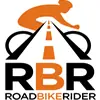Follow the Leader(s)
The riders in front determine which way you should rotate depending on the wind and traffic, usually. If the wind is from the side, rotate into it if traffic allows. If the side wind is strong enough, riders may overlap wheels and form what's known as an echelon (assuming there's enough space on the road).
If you're riding into a headwind, rotate to whichever side is safest based on traffic. In many cases, traffic alone will dictate the rotation side—regardless of wind direction. It should be easy to follow what the leaders set as the "rules." And, if they know what they're doing, it'll be the most efficient and fastest way to ride down the road.
Keep Some Safety Space
Unless you're riding with cyclists you know and trust, there's no need to ride inches from the wheel you're following. Allowing a gap of two feet or more gives you room to maneuver in case of mishaps or obstacles in the road. This is especially important on organized rides or centuries where you're likely to form up with riders you don't know and can't necessarily trust like you can your buddies.
Look up the Road
Don't fixate on the rear wheel just ahead. Look around that rider and up the road so you can anticipate things (turns, potholes, traffic) that may cause a reaction by those ahead of you. Let the lower edge of your peripheral vision monitor the gap in front of your wheel.
More: Rules and Etiquette for Group Rides
Protect Your Wheel
Touching wheels with the bike in front of you is one of the leading causes of crashes in a paceline. And you will crash, not the rider in front of you—so be sure to protect your wheel.
If you do happen to touch wheels, don't panic. Remember to turn into—not away from—the wheel you're rubbing, so that you ease off the pedal pressure and fall back just enough to get clear of the wheel you're following. Then smoothly apply power to get back to your proper position. If you do this right, the rider in front of you might not even realize you've touched his or her wheel.
Don't Get Distracted
Most crashes in pacelines are caused by distractions outside of the paceline, like a dog running from a yard. The key is to always remember that the biggest hazard is the rider in front of you, not anything on the side of the road, up the road or behind you. Your job is to pay attention to that rider and not react to much else.
Ride in the Drops
Doing so keeps you in the most aero position, which helps with the overall energy savings you'll reap, and the overall efficiency of the paceline—which is one of the reasons you ride in a paceline.
Riding in the drops also has the added benefit of protecting you from being "hooked" by another rider's bar. As riders are moving back down the line, or sometimes in a double paceline, there's a chance of being hit from the side and getting your bar hooked by someone else's bar, which can take you down in an instant. In effect, by riding in the drops, you "seal off" the bar ends with your arms, making hooking impossible.
Communicate
Pacelines are often quiet unless you're riding in a double pacelines at a conversational pace. When groups are going faster—and the danger is greater—let your fellow riders know what's going on. There's no need to shout out obstacles. Merely pointing at them is sufficient. But if there's a question about the next intersection, or a turn, it's far better to tell, or ask, than to guess.



